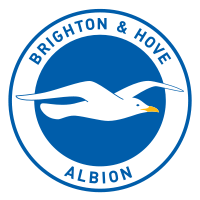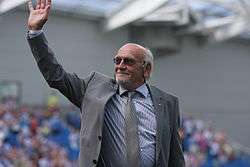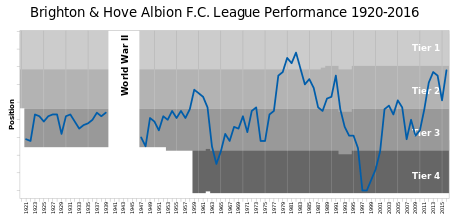Brighton & Hove Albion F.C.
 | ||||
| Full name | Brighton & Hove Albion Football Club | |||
|---|---|---|---|---|
| Nickname(s) |
The Seagulls The Albion | |||
| Founded | 24 June 1901 | |||
| Ground | The Amex | |||
| Capacity | 30,750 | |||
| Chairman | Tony Bloom | |||
| Manager | Chris Hughton | |||
| League | Championship | |||
| 2015–16 | Championship, 3rd | |||
| Website | Club home page | |||
|
| ||||
Brighton & Hove Albion Football Club /ˈbraɪtən ən ˈhoʊv/ is a professional association football club based in the city of Brighton & Hove, East Sussex, England. It is often referred to simply as Brighton. They currently play in the Championship, the second tier of the English football league system, hosting games at the 30,750-capacity Falmer Stadium, known for sponsorship purposes as the American Express Community Stadium, or simply the Amex.
The team is nicknamed the "Seagulls" or "Albion". The team has historically played in blue and white stripes, though this changed to all white briefly in the 1970s and again to plain blue during the club's most successful spell in the 1980s.[1] Crystal Palace is considered the club's main rival, although the grounds are 40 miles apart.[2][3]
Founded in 1901, Brighton played their early professional football in the Southern League before being elected to the Football League in 1920. The club enjoyed greatest prominence between 1979 and 1983 when they played in the First Division and reached the 1983 FA Cup Final, losing to Manchester United after a replay.[4] They were relegated from the top division in the same season. Mismanagement brought Brighton close to relegation from the Football League to the Conference which they narrowly avoided in 1997 and 1998. A boardroom takeover saved Brighton from liquidation, and following successive promotions they returned to the second tier of English football in 2002 and have played in the second and third tiers ever since.
History

Brighton & Hove Albion F.C. were founded in 1901 and 19 years later, in 1920, they were elected to the Football League's new Third Division — having previously been members of the Southern League. In the Southern League they won their only national honour to date, the FA Charity Shield, which at that time was contested by the champions of the Southern League, and the Football League, by defeating Football League Champions Aston Villa in 1910.[5]
Mike Bamber was the chairman of Brighton from October 1972 until 1983. He famously brought Brian Clough to the club in 1973 and later appointed former England player Alan Mullery as manager. Brighton's life as a Football League club had brought little in the way of success and headlines until 1979, when, under Mullery's management, they were promoted to the First Division as Second Division runners-up. The 1982/83 season saw a wildly inconsistent start for the club, with victories over Arsenal and Manchester United mixed in with heavy defeats. Manager Mike Bailey eventually lost his job at the start of December 1982. Jimmy Melia took over as manager, but was unable to turn the situation around and Brighton were relegated in 1983, having finished in bottom place.
Despite their relegation, that season Brighton reached their first (and only to date) FA Cup final and drew 2–2 with Manchester United in the first match. Brighton's goals were scored by Gordon Smith and Gary Stevens. This was the final that featured the "miss" by Gordon Smith with virtually the last kick of the game in extra time, prompting the BBC commentator John Motson to utter the well known phrase "...and Smith must score". However, Smith's kick was actually saved by the Manchester United goalkeeper, Gary Bailey. In the replay, Manchester United won 4–0.
In 1996, the club's financial situation was becoming increasingly precarious and the club's directors had come to a decision that the Goldstone Ground would have to be sold to pay off some of the club's huge debts. Manager Jimmy Case was sacked after a terrible start to 1996–97 saw Brighton stuck the bottom of the league by a considerable margin – they seemed certain to be relegated from the Football League just 14 years after they had almost won the FA Cup. The club's directors, who appeared to have little concern about the on-field fortunes of the club, appointed a relative unknown in Steve Gritt, the former joint manager of Charlton Athletic, in hope of performing a miracle survival. Brighton's league form steadily improved under Gritt, although their improving chances of survival were put under further threat by a two-point deduction imposed as punishment for a pitch invasion by fans who were protesting against the sale of the Goldstone ground. A lifelong fan named Dick Knight took control of the club in 1997 having led the fan pressure to oust the previous board following their sale of the club's Goldstone Ground to property developers.

By the last day of the season, after being 13 points adrift at one stage, they were off the bottom of the table and had to play the team directly below them, Hereford United — the game was in their hands. If Brighton won or drew, they would be safe. Brighton defender Kerry Mayo scored an own goal in the first half and it looked as though their 77-year league career was over. But a late goal from Robbie Reinelt saved the day, Brighton retained their league status on goal difference, and Hereford's 25-year league run was instead over.
The sale of the Goldstone ground went through in 1997, leading to Brighton having to play some 70 miles away at Gillingham's Priestfield stadium for two seasons. Micky Adams was appointed Brighton's manager in 1999. For the start of the 1999–2000 season the Seagulls secured a lease to play home games at Withdean Stadium, a converted athletics track in Brighton owned by the local council. In February 2000 Brighton signed a little known forward on loan from Bristol Rovers called Bobby Zamora. Zamora made an instant impact, scoring in his debut, the 1–1 home draw with Plymouth.
2000–01 was Brighton's first successful season for 13 years. They were crowned champions of Division Three and promoted to Division Two, where they made an excellent start and looked good bets for a second successive promotion. Adams left in October 2001 to work as Dave Bassett's assistant at Leicester, being replaced by former Leicester manager Peter Taylor. The transition proved to be a plus point for Brighton, who maintained their good form and ended the season as Division Two champions – winning a second successive promotion. Just five years after almost succumbing to the double threat of losing their Football League status and going out of business completely, Brighton were one division away from the Premier League.
During May 2009, Knight was replaced as chairman at Brighton by Tony Bloom, who had successfully secured £93 million funding for the new Falmer Stadium and secured 75% shareholding at the club.[6]
Stadium

For many years Brighton and Hove Albion were based at the Goldstone Ground in Hove, until the board of directors decided to sell the stadium. The sale, implemented by majority shareholder Bill Archer and his chief executive David Bellotti, proved controversial, and the move provoked widespread protests against the board. The club received little if any money from this sale.[7]
In their last season at the Goldstone, 1996–97, the Seagulls were in danger of relegation from the Football League. They won their final game at the Goldstone against Doncaster Rovers,[8] setting up a winner-takes-all relegation game at Hereford United, who were level on points with the Seagulls. Brighton drew 1–1, and Hereford were relegated to the Football Conference on goals scored.[9]
For two years, from 1997–99, the club shared Priestfield Stadium, the ground of Gillingham, before returning to Brighton to play at Withdean Stadium. This is not predominantly a football ground, having been used for athletics throughout most of its history, and previously as a zoo.[10]
Because of the cost of the public enquiry into planning permission for a new stadium, rent on Withdean Stadium, fees paid to use Gillingham's Priestfield Stadium, and a general running deficit due to the low ticket sales inherent with a small ground, the club had an accumulated deficit of £9.5 million in 2004. The board of directors paid £7 million of this; the other £2.5 million had to be raised from the operations of the club. In an effort to achieve this, a fund-raising appeal known as the Alive and Kicking Fund was started, with everything from nude Christmas Cards featuring the players to a CD single being released to raise cash. On 9 January 2005 this fund-raising single 'Tom Hark' went straight in at number 17 in the UK chart, gaining it national airplay on BBC Radio 1.[11]
On 28 October 2005 the Office of the Deputy Prime Minister announced that the application for Falmer had been successful, much to the joy and relief of all the fans. Lewes District Council contested John Prescott's decision to approve planning permission for Falmer, forcing a judicial review. This was based on a minor error in Prescott's original approval which neglected to state that some car parking for the stadium is in the Lewes district as opposed to the Brighton & Hove unitary authority. This caused further delay. Once the judicial review ruled in favour of the stadium, Lewes District Council said that it would not launch any further appeals.
Building of Falmer Stadium started in December 2008. On 31 May 2011 the club officially completed the handover and was given the keys to the stadium with an initial capacity of 22,374 seats, signifying the end of 12 years without a home. During January 2012, the club submitted an application to Brighton and Hove City council to increase the stadium capacity by a further 8,000 seats as well as to add additional corporate boxes, new television facilities and a luxury suite.[12] This was granted unanimously by Brighton & Hove City Council's planning committee on 25 April 2012. The stadium was then expanded to 27,250 for the start of the 2012–13 season and then further to 27,750 during December 2012 before reaching 30,750 during May 2013.
Players
Current squad
Note: Flags indicate national team as defined under FIFA eligibility rules. Players may hold more than one non-FIFA nationality.
|
|
Development squad and youth team
Note: Flags indicate national team as defined under FIFA eligibility rules. Players may hold more than one non-FIFA nationality.
|
|
Out on loan
Note: Flags indicate national team as defined under FIFA eligibility rules. Players may hold more than one non-FIFA nationality.
|
|
Managers
|
|
|
See Soccerbase for full managerial history
Current management team
| Position | Name |
|---|---|
| Manager | Chris Hughton |
| Assistant manager | Paul Trollope |
| First team coach | Paul Nevin |
| Goalkeeping coach | Ben Roberts |
| Youth team goalkeeping coach | Casper Ankergren |
| Academy manager | John Morling |
| Development squad coach | Simon Rusk |
| Youth team manager | Ian Buckman |
| Youth team coach | Vic Bragg |
| Head of medical services | Adam Brett |
| Club doctor | Dr. Stephen Lewis |
| Sports scientist | Martin Springham |
| Assistant physio | Paul Watson |
| Assistant physio | Sam Blanchard |
| Fitness coach | Thomas Barnden |
Personnel
Club officials
| Position | Staff |
|---|---|
| Chairman | Tony Bloom |
| Chief executive | Paul Barber |
| Directors | Ray Bloom Derek Chapman Robert Comer Adam Franks Marc Sugarman Peter Godfrey |
| Executive director | Martin Perry |
| Finance director | David Jones |
| Life president | Dick Knight |
| Club secretary | Derek Allan |
Source: Who's Who
Honours

Domestic
League
- Football League Third Division South/Football League Third Division/Football League Second Division/Football League One
- Southern Football League
- Winners (1) 1909–10
Cup
- Winners (1): 1910
- Winners: (2) 1959–60, 1960–61[note 1]
Shirt sponsors and manufacturers
| Season(s) | Shirt manufacturer | Main sponsor | Secondary sponsor | Home stadium |
|---|---|---|---|---|
| 1902–1971 | B&HA | n/a | n/a | Goldstone Ground, Hove |
| 1971–1974 | Bukta | |||
| 1974–1975 | Admiral | |||
| 1975–1977 | Umbro/Bukta/B&HA | |||
| 1977–1980 | Bukta | |||
| 1980–1983 | Adidas | British Caledonian Airways | ||
| 1983–1986 | Phoenix Brewery | |||
| 1986–1987 | NOBO | |||
| 1987–1989 | Spall | |||
| 1989–1991 | Sports Express | |||
| 1991–1993 | Ribero | TSB Bank | ||
| 1993–1994 | Sandtex | |||
| 1994–1997 | Admiral | |||
| 1997–1998 | Superleague | Priestfield, Gillingham | ||
| 1998–1999 | Donatello | |||
| 1999–2008 | Erreà | Skint | Withdean | |
| 2008–2011 | IT First | |||
| 2011–2013 | BrightonandHoveJobs.com | Donatello | Falmer Stadium | |
| 2013–2014 | American Express | n/a | ||
| 2014– | Nike |
See also
References
- ↑ shared with Chichester City in 1960–61
- ↑ "Brighton & Hove Albion". Historical Football Kits. Retrieved 6 September 2011.
- ↑ "Club Rivalries Uncovered Results" (PDF). FootballFanCensus. Archived from the original (PDF) on 20 October 2013. Retrieved 6 September 2011.
- ↑ Burnton, Simon (2011) How Brighton v Crystal Palace grew into an unlikely rivalry, The Guardian, 27 September (Accessed Dec 2012)
- ↑ "1983 FA Cup Final". Fa-CupFinals.co.uk. Retrieved 6 September 2011.
- ↑ Brighton & Hove Albion Talk Football. Retrieved 9 August 2011
- ↑ Stadium Funding Secured, Brighton & Hove Albion F.C., 18 May 2009. Retrieved 18 May 2009
- ↑ "Club in Crisis – Brighton". Club in Crisis. Retrieved 6 September 2011.
- ↑ "WELCOME – BRIGHTON & HOVE ALBION". Doncaster Rovers F.C. 16 May 2011. Retrieved 6 September 2011.
- ↑ "WE ARE STAYING UP". YouTube. Retrieved 6 September 2011.
- ↑ "Withdean Stadium". Royal Pavilion & Brighton Museums. Retrieved 6 September 2011.
- ↑ "Brighton fans single makes top 20". BBC. 10 January 2005. Retrieved 6 September 2011.
- ↑ "Albion's £36 million plans to push for Premiership". The Argus. 2 January 2012. Retrieved 4 January 2012.
- ↑ "Starkey signs". Brighton & Hove Albion F.C. 26 August 2013. Retrieved 26 August 2013.
- ↑ "Ward joins development squad". Brighton & Hove Albion F.C. 3 June 2015. Retrieved 24 June 2015.
- ↑ "R.U.R. Cup Final Results – Sussex County Football Association". Sussexcountyleague.com. Retrieved 11 November 2012.
External links
| Wikimedia Commons has media related to Brighton & Hove Albion F.C.. |